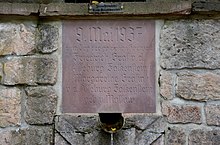Friedrich von der Asseburg
Friedrich Georg Theodat Graf von der Asseburg (born February 11, 1861 in Neudek , Bohemia , † April 1, 1940 in Meisdorf ) was a Prussian major and chamberlain and owner of Falkenstein Castle in the Harz Mountains .
origin
Friedrich was the son of Bernhard Friedrich Graf von der Asseburg and Anna Maria Rosalia Ferdinande , née Freiin von Kleist, and initially had Austrian citizenship.
Life
He grew up in the Bohemian town of Neudek, where he received private lessons, but lost his father at the age of eight in 1869. From Easter 1876 to Easter 1878 he attended the Roßleben convent school , which he had to leave early due to his foreign nationality. He continued his education at the KK State High School in Eger . He was confirmed on June 9, 1878 in the Protestant community there.
On September 22, 1881, he joined the Prussian Army with the 7th Cuirassier Regiment von Seydlitz in Halberstadt . In 1883 he was promoted to second lieutenant. He stayed mostly in the Quedlinburg garrison before he was transferred to the Guard Corps regiment in Potsdam in 1886 and in 1891 as adjutant of the 1st Guard Cavalry Brigade in Berlin . At his own request he was placed à la suite in 1893 and transferred to the reserve in 1894. In 1897 he was appointed Rittmeister and in 1906 he retired from military service.
On May 9, 1887, he married in Steinhöfel in the Mark Margarethe von Massow, with whom he moved in 1893 to Demnitz , his mother-in-law's estate. There he acquired agricultural knowledge. The following year he bought the Groß Rinnersdorf estate in Silesia, where he stayed with his family from 1895 to 1909.
After the death of his uncle, Count Ludwig II of the Asseburg, he inherited the Fideikommissherrschaft Meisdorf-Falkenstein in the Prussian province of Saxony . That is why he moved permanently to the Harz Mountains and from then on called himself Graf von der Asseburg-Falkenstein. Under his direction, the Meisdorf Castle was expanded and the Falkenstein Castle restored.
When the First World War broke out, he returned to the military, worked as a stage delegate in almost all theaters of war and, most recently, as a major and territorial delegate in Brussels .
After the end of the war he returned to the Harz Mountains, where he took great care of his goods. He became a co-founder of the Association of Forest Owners and the Reich Association of German Forest Owners , which he chaired. Furthermore, he was chairman of the committee of the landscape of the province of Saxony for ten years and from 1930 commendator of the Saxon provincial cooperative of the Order of St. John . He was also a hereditary member of the Prussian mansion and in 1912 was appointed Prussian Chamberlain.
Graf von der Asseburg-Falkenstein died on April 1, 1940 after a six-month period of serious illness.
Meisdorf Castle , Harz
Groß Rinnersdorf in Silesia
family
He married Margarethe von Massow , daughter of Valentin von Massow and his aunt Adelheid Marianne von der Asseburg , on May 9, 1887 in Steinhöfel . A memorial plaque attached to the Strulle in Meisdorf commemorates the golden wedding on May 9, 1937 . The couple had several children:
- Oda Mechtildis Anna Adelheid (* October 13, 1888; † June 8, 1928) ∞ Count Leonhard Alfred von Rothkirch-Trach (* October 22, 1882)
- Marie-Agnes Bia Sibylle Brigitte Margarete Charlotte Bernhardine (* October 23, 1889 - † October 7, 1960) ∞ Count Friedrich Rudolf Alfred Erwin Finck von Finckenstein (* June 3, 1881 - † June 10, 1957)
- Ilse Irmgard Anna Gabriele, (* March 17, 1893; † November 23, 1976) ∞ Woldemar von Trotha (* May 17, 1882)
- Busso-Bernhard Ludwig Egbert Tino Deodat (born June 3, 1899: † June 15, 1928)
See also
literature
- Valentin von Massow: The conquest of North Togo 1896–1899: diaries and letters. Bremen 2014, ISBN 978-3-95494-042-4 .
Individual evidence
- ↑ Valentin von Massow: The conquest of Nordtogo 1896-1899: diaries and letters. Bremen 2014, ISBN 978-3-95494-042-4 , p. 8. ( digital )
| personal data | |
|---|---|
| SURNAME | Asseburg, Friedrich von der |
| ALTERNATIVE NAMES | Asseburg, Friedrich Georg Theodat Graf von der |
| BRIEF DESCRIPTION | Prussian major and chamberlain and owner of Falkenstein Castle in the Harz Mountains |
| DATE OF BIRTH | February 11, 1861 |
| PLACE OF BIRTH | Neudek Castle in Bohemia |
| DATE OF DEATH | April 1, 1940 |
| Place of death | Meisdorf |



